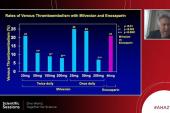‘Agnostic’ EHR Alerts Boost VTE Prophylaxis in Hospitals and Postdischarge
Key to this tool is its universality, making it particularly useful for rural and nonacademic centers where VTE prophylaxis is rare.

A clinical-decision tool integrated into electronic health records (EHRs) can help physicians identify patients who are at risk for venous thromboembolism (VTE), implement therapy, and decrease thrombotic events, according to data from the IMPROVE-DD VTE trial.
The results were presented at the American Heart Association 2022 Scientific Sessions in Chicago, IL.
Currently, only a little over half of hospitalized patients and less than 4% of postdischarge patients at increased risk for VTE receive appropriate thromboprophylaxis, noted Alex C. Spyropoulos, MD (Donald and Barbara Zucker School of Medicine at Hofstra/Northwell, Hempstead, NY). Electronic alerts and some large initiatives have shown promise for increasing medical therapy and reducing symptomatic VTE, but the alerts tend not to be interoperable across EHRs and initiatives can be labor intensive, costly, and difficult to apply outside national health systems, he added.
The group led by Spyropoulos tested a universal, platform agnostic, digital VTE risk score with integrated clinical decision support that could be used across EHRs. The embedded risk score they used is IMPROVE-DD, which adds D-dimer as a recognized risk factor to the standard IMPROVE score. The cluster RCT included four hospitals—two where doctors used the intervention for patients and two where they did not.
“The primary outcome of appropriate in-hospital thromboprophylaxis was significantly increased in the intervention group versus control group, with a rate of 80.1% versus 72.5%,” Spyropoulos said in his presentation. “This represented a 52% relative increase or an 8% absolute increase.”
Those in the intervention group who received extended prophylaxis at discharge also saw improvements in the rate of appropriate thromboprophylaxis, with a 93% relative increase (6% absolute increase) compared with the control group.
Speaking as the discussant in the session, Elaine Hylek, MD (Boston University School of Medicine, MA), noted that the first indication that a computerized alert could improve VTE thromboprophylaxis in hospitalized patients came from a study published 17 years ago. Despite this, VTE prophylaxis remains underutilized, although Hylek commended the “outrageous, amazing” rate of 72.5% in the control groups across the four hospitals in this study as evidence of progress. In his presentation, Spyropoulos explained that the high rate of thromboprophylaxis also suggests that the tool might confer greater benefit if used in nonacademic, community, and rural hospitals, whose rates historically tend to be lower than those of large urban, academic centers.
Although trials such as EXCLAIM, ADOPT, and MAGELLAN raised concern about bleeding as a trade-off of VTE prophylaxis, patients in the intervention arm of IMPROVE-DD VTE did not see an increase compared with usual care, Hylek noted. But the intervention group did have higher rates of 30-day all-cause mortality than did the usual-care group, at 9.1% versus 7.0% (P < 0.001), which she said raises concerns about selection bias. Another factor that may have been at play, as noted by Spyropoulos, was that the trial design did not allow for ascertainment of continuous adherence to the prescribed prophylaxis.
IMPROVE-DD VTE Outcomes
The trial investigators enrolled 5,450 patients from hospitals using the intervention and 7,632 where it was not being used. Mean ages were 75 in the intervention group and 74 in the control group, with more than 50% of all participants being female. Compared with the control group, the intervention group had higher prevalence of Black and Asian patients. D-dimer levels were more than two times the upper limit of normal in 11% of those in the intervention arm and 14% in the control arm. Since the intervention was conducted during the height of the COVID-19 pandemic in New York, high numbers of patients in each group were positive for the virus—26% of the intervention group and 21% of controls.
Physicians at intervention hospitals encountered the risk assessment tool both during in-hospital prophylaxis ordering and at discharge during the medication reconciliation process. “The tool uses sophisticated architecture as well as front-end interfaces and back-end data systems to communicate with each other,” Spyropoulos explained in his presentation.
When the tool launched, answers to yes/no questions were automatically filled in based on existing data from the EHR. However, manual adjustment of the eight individual questions was possible and could be done as needed. When the user clicked “calculate probability,” the IMPROVE-DD score and the 3-month VTE risk percentage were displayed. When the user then clicked “record results and proceed,” the tool would close, writing the score into the EHR and displaying the prophylaxis recommendations.
In addition to the greater reduction in VTE at 30 days, patients in the intervention group also had a lower rate of arterial thromboembolism (ATE) compared with controls (0.25% vs 0.70%; P < 0.001) and a lower rate of combined VTE and ATE (2.9% vs 4.0%; P = 0.002). Major bleeding was similar in both groups (P = 0.42), as were rates of all-cause readmission/death (P = 0.41) and VTE-related readmission/death (P = 0.07).
While more research is needed, Spyropoulos said, “in theory” the tool could be used in any hospital environment among acutely ill patients over age 60, except those who have some prehospital use of anticoagulants or who have atrial fibrillation. Study participants typically were hospitalized for HF exacerbation or acute respiratory insufficiency, infectious disease, inflammatory disease, or stroke.
Hylek noted that it is unclear how many patients actually had their D-dimer checked and that the study does not clarify the issue of individual patient risk/benefit of VTE prophylaxis. Importantly, Hylek added that “there were too few patients that received a postdischarge prophylaxis to inform this still perplexing clinical question.”
Patients receiving extended postdischarge medications for VTE prevention accounted for just 331 patients in the intervention group and 195 in the control group.
L.A. McKeown is a Senior Medical Journalist for TCTMD, the Section Editor of CV Team Forum, and Senior Medical…
Read Full BioSources
Spyropoulos AC. Universal electronic health record clinical decision support for prevention of thromboembolism in hospitalized medically ill patients: The IMPROVE-DD VTE cluster randomized trial. Presented at: ACC 2022. November 7, 2022. Chicago, IL.
Disclosures
- Spyropoulos reports research support from Janssen and Boehringer Ingelheim; consulting fees from Janssen, Bayer, BMS, Boehringer Ingelheim, Sanofi, and Pfizer; honoraria from Sanofi; and serving on a scientific advisory board for ATLAS group.
- Hylek reports research support from Abbott, Anthos, Bristol Myers Squibb, Janssen, and Medtronic; consulting fees from Bayer and Ionis; and honoraria from Boehringer Ingelheim and Pfizer.





Comments